Key Points
- Native to the Americas: Popular for its unique appearance, vibrant flowers, and edible fruits.
- Cultural Significance: Important in Mexican cuisine and traditions, used for medicinal purposes and art.
- Versatile Varieties: Available in many sizes, shapes, and colors to fit any garden.
- Selecting the Right Type: Consider climate, frost tolerance, and growth patterns when choosing an Opuntia.
- Growing Methods: Propagate from seeds, cuttings, or offsets (pups) during the growing season.
- Care Tips: Needs well-draining soil, plenty of sunlight, and occasional watering. Avoid overwatering.
- Pest Management: Keep an eye out for pests like aphids; use organic treatments if needed.
- Pruning and Repotting: Prune to maintain shape and repot every few years for healthy growth.
- Creative Garden Use: Works well in garden arrangements, pots, or xeriscapes.
- Culinary Uses: The prickly pear fruit can be eaten raw, used in salads, drinks, jams, or grilled.
- Health Benefits: Rich in vitamins and antioxidants, supports digestive health, and used in skincare.
The Fascinating World of Opuntia
Introduction to Opuntia
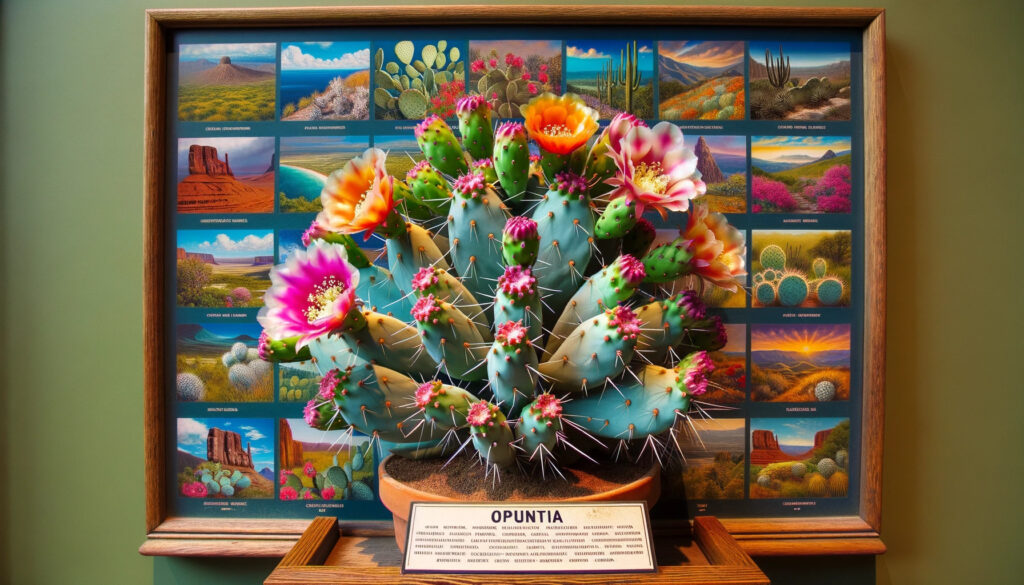
Opuntia, also called the prickly pear cactus, is a plant that belongs to the Cactaceae family. Native to North and South America, this cactus is popular among garden lovers because of its interesting look, colorful flowers, and edible fruits. Opuntia has a long history and is important in many cultures. It is loved not only for how it looks but also for its use in cooking, medicine, and even art.
Opuntia plants come in many sizes, shapes, and colors, which makes them a great choice for any garden. You can use them as a stunning focal point, mix them with other succulents, or grow them for their tasty fruits. Opuntia is a versatile plant that fits many gardening needs.
History and Cultural Significance of Prickly Pear Cactus
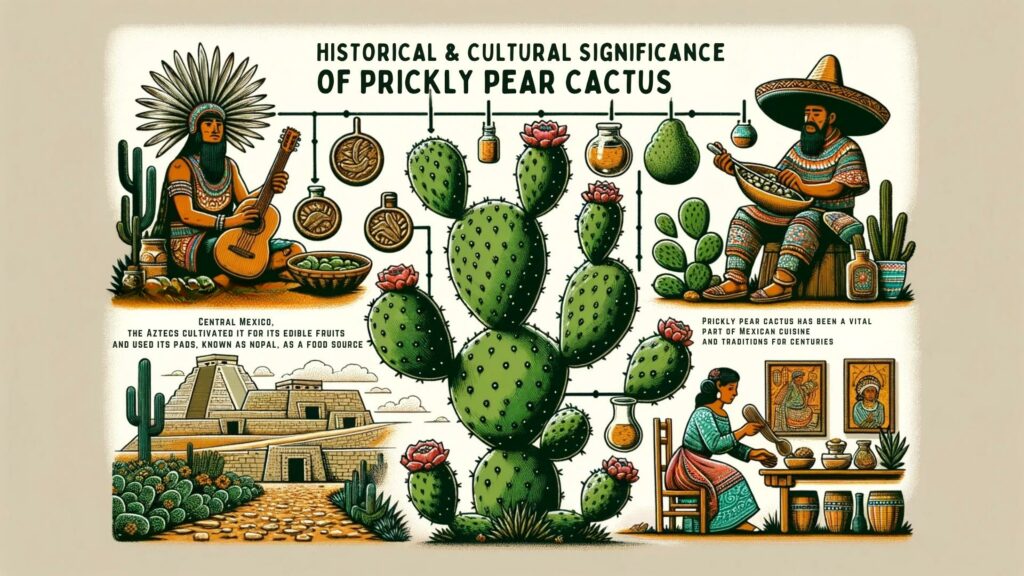
Opuntia has been around for thousands of years and has deep cultural roots. In Central Mexico, the Aztecs grew Opuntia for food, using both its fruits and pads (called nopal). The prickly pear cactus has been a key part of Mexican cooking for generations and has also been used as medicine. Beyond food and health, Opuntia has been featured in art, literature, and even religious ceremonies. The cochineal insect, which feeds on Opuntia pads, has been used to make red dye that was highly valuable to both the Aztecs and European colonizers. This dye became an important export, showing how culturally and economically important Opuntia is.
Because Opuntia is tough and adaptable, it has spread to many parts of the world, including the Mediterranean and Australia. In many cultures, it symbolizes survival and strength, representing the ability to thrive even in harsh conditions.
Different Types of Opuntia
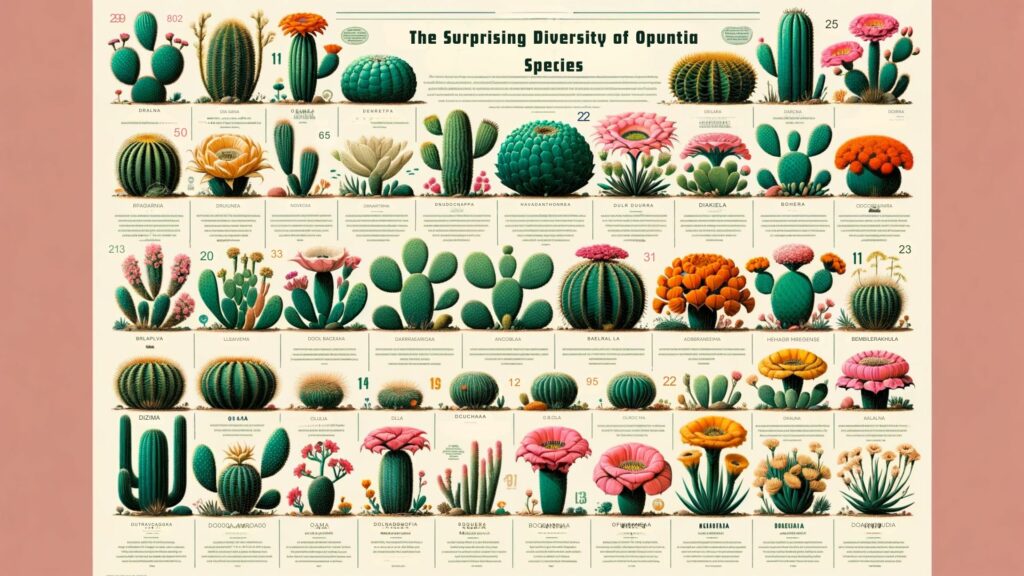
Opuntia is a diverse group of plants with many different types, each with its own features:
- Growth Forms: Opuntia comes in many forms, from small, low-growing types to tall, tree-like ones. Some species are perfect for thick, protective hedges, while others look great in pots.
- Spines: The spines of Opuntia can be different lengths and colors. Some have long, sharp spines, while others have short, tiny spines called glochids that can be irritating if touched. Some types even have no spines, making them easier to handle.
- Colorful Flowers: The flowers of Opuntia bloom in colors like yellow, orange, red, and pink. These blooms not only look beautiful but also attract pollinators like bees and butterflies, which is great for your garden.
Knowing about the different types of Opuntia can help you pick the best one for your garden. Here are some common types of Opuntia:
- Opuntia ficus-indica (Indian Fig Cactus): A large, tree-like cactus that produces tasty prickly pear fruits. It grows well in warm, dry climates.
- Opuntia humifusa (Eastern Prickly Pear): A low-growing cactus that is cold-hardy and suitable for temperate climates. It produces yellow flowers and small, edible fruits.
- Opuntia engelmannii (Engelmann’s Prickly Pear): This type can grow up to 10 feet tall and has large pads with long spines. It is often used as a decorative plant in desert gardens.
- Opuntia basilaris (Beavertail Cactus): A spineless cactus with flat, blue-gray pads and beautiful pink flowers. It is great for gardeners who prefer a cactus without spines.
- Opuntia robusta (Wheel Cactus): Known for its large, round pads, this cactus can tolerate higher humidity and is often used for hedges or as a striking focal point.
- Opuntia microdasys (Bunny Ears Cactus): A smaller cactus with no true spines but covered in tiny, hair-like glochids. It is ideal for indoor pots and adds charm to any small space.
- Opuntia polyacantha (Plains Prickly Pear): A hardy cactus that grows in clumps, making it perfect for ground cover. It is known for its bright yellow or pink flowers.
Whether you want a small cactus for a limited space or a big one that makes a statement, there is likely an Opuntia that will suit your needs.
Choosing the Perfect Opuntia for Your Garden
Understanding Different Types
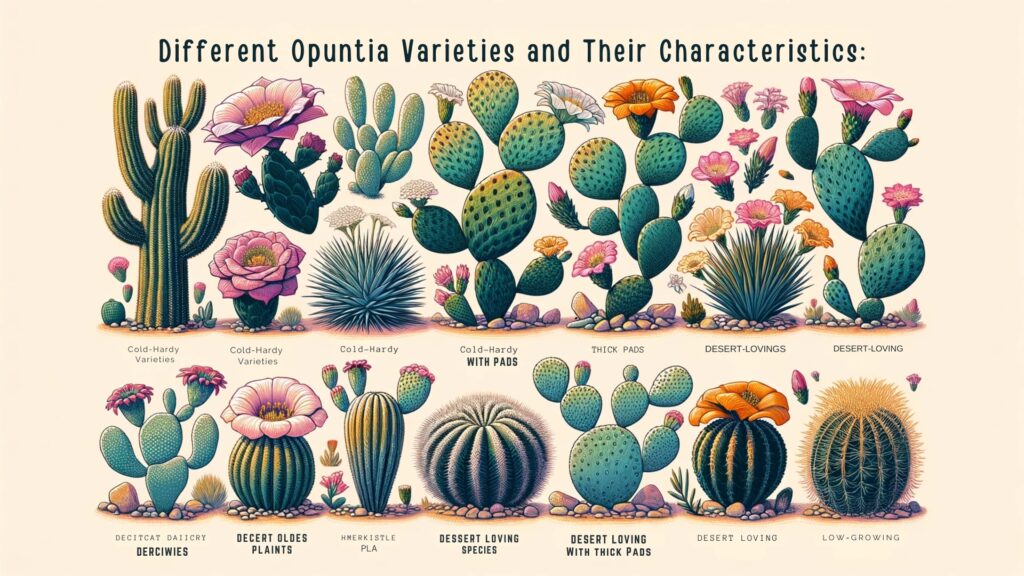
Picking an Opuntia for your garden means understanding the different kinds:
- Cold Hardiness: Some types can handle frost, while others prefer warmer climates. For example, Opuntia humifusa can tolerate cold weather, while Opuntia ficus-indica grows best in warm, dry places.
- Growth Habit: Some Opuntia types grow low to the ground, making them great for ground cover, while others grow tall, like Opuntia engelmannii, which can grow up to 10 feet tall in the right conditions.
Consider your climate
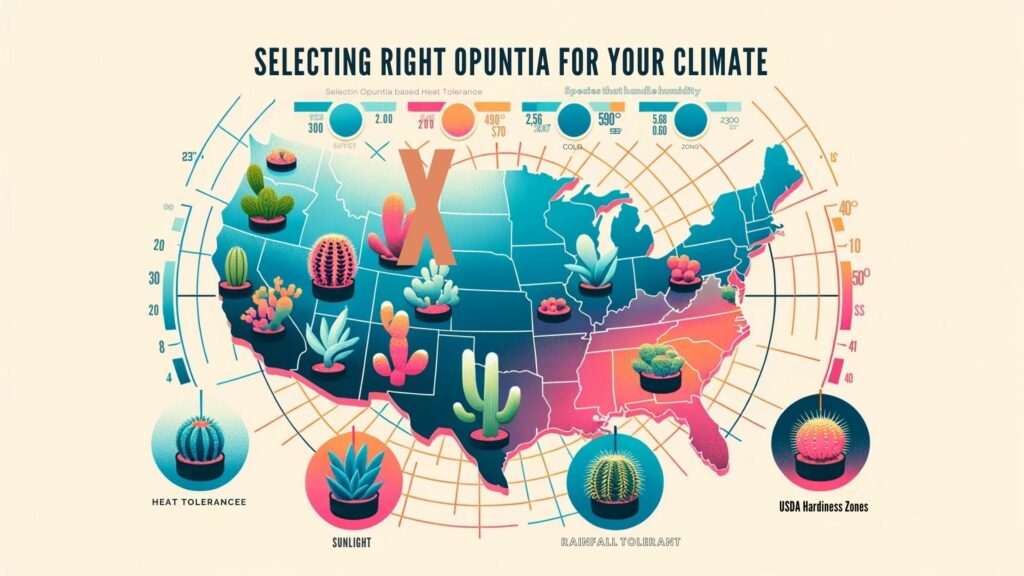
You need to think about your local climate when picking an Opuntia:
- USDA Hardiness Zones: Find out what plants grow best in your region’s hardiness zone. This will help you choose the right Opuntia type that can survive in your area.
- Sunlight, Rain, and Humidity: Some species like desert-like conditions, while others can handle more humidity. For example, Opuntia robusta can deal with higher humidity compared to other species.
Talking to local gardening experts can also help you find the perfect cactus for your area. They can give you advice on which types grow well locally and how to take care of them.
Navigating the Unique Challenges of Opuntia Propagation
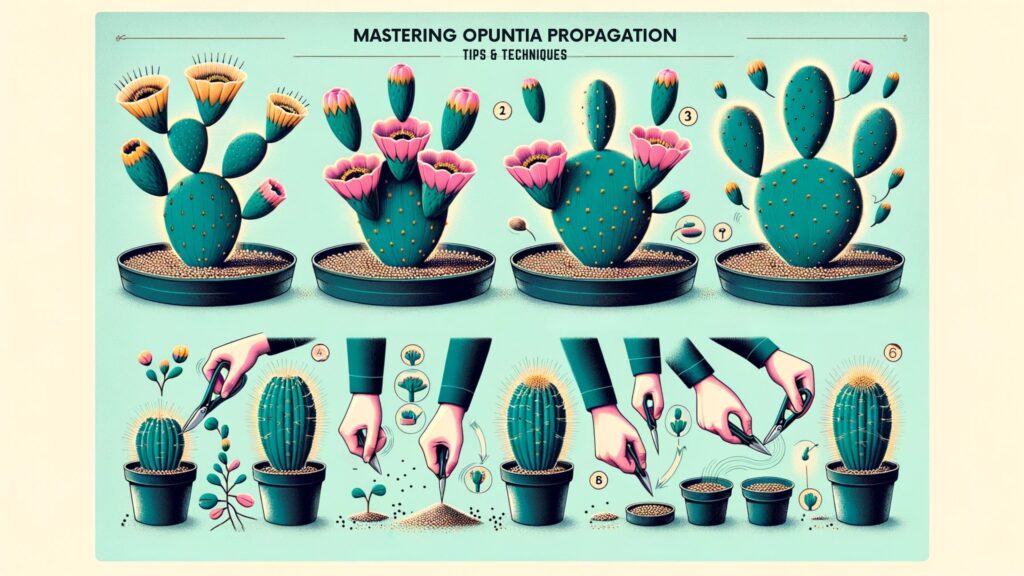
Growing new Opuntia plants can be fun, but it does take some effort. There are a few different ways to grow them, depending on the type:
- Seeds or Cuttings: You can grow Opuntia from seeds or cuttings. Growing from seeds takes a lot of time and patience, but growing from cuttings is usually faster and easier. To grow from a cutting, simply cut a pad off, let it dry and heal (called callousing), then plant it.
- Offsets (Pups): Many Opuntia plants produce baby plants called pups at their base. These can be replanted, and it’s one of the easiest ways to grow more Opuntia since they are just like the parent plant and grow roots easily.
Knowing how to use specific propagation methods will help you successfully grow more Opuntia plants. It’s also important to choose the right time—propagation works best during the growing season when the plant is active, not when it’s dormant.
Tips for Taking Care of Opuntia Cactus
Best Growing Conditions for Prickly Pear Cactus
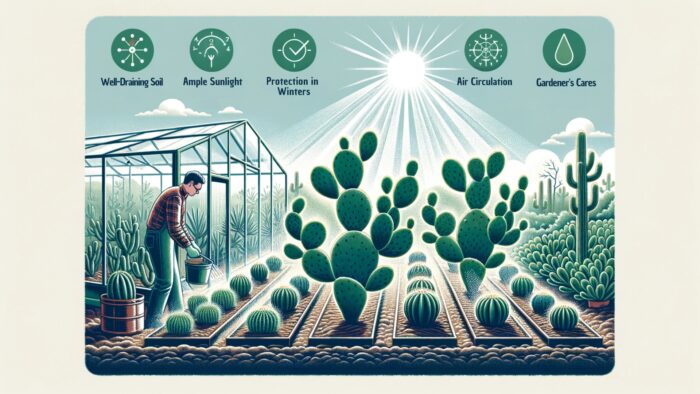
Opuntia does well in well-draining soil, like sandy soil or cactus mix. They need at least six hours of direct sunlight each day, and good air circulation helps prevent disease. If you’re growing Opuntia indoors, put it in a sunny spot, like near a south-facing window, so it gets enough light.
The soil needs to drain well so water doesn’t sit around the roots, which can cause root rot. Adding things like perlite or pumice can help improve soil drainage and create the best growing environment for Opuntia.
Watering Techniques and Strategies for Opuntia
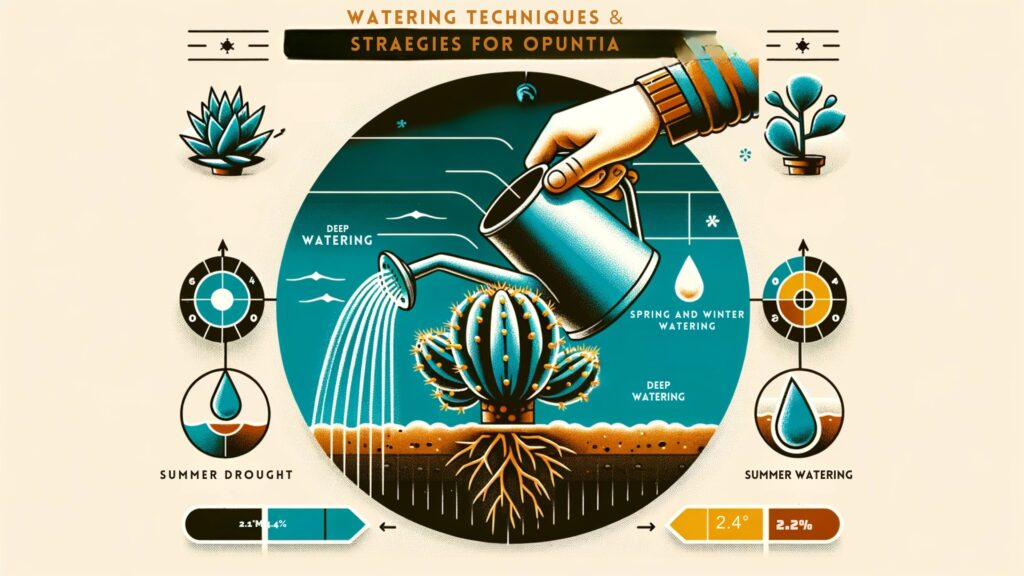
Don’t overwater your Opuntia, as this can lead to root rot. Water sparingly but deeply, and let the soil dry out completely between waterings:
- Growing Season: During spring and summer, when Opuntia is actively growing, you may need to water it every two to four weeks, depending on your climate. Guide to Watering Cacti
- Dormant Season (Winter): In winter, Opuntia needs much less water, often only once every six to eight weeks.
Watch for water stress signs, like wrinkling pads (which means they need water) or discoloration (which can mean too much water). Adjust your watering schedule to keep your Opuntia healthy.
Protecting Your Opuntia from Pests and Diseases
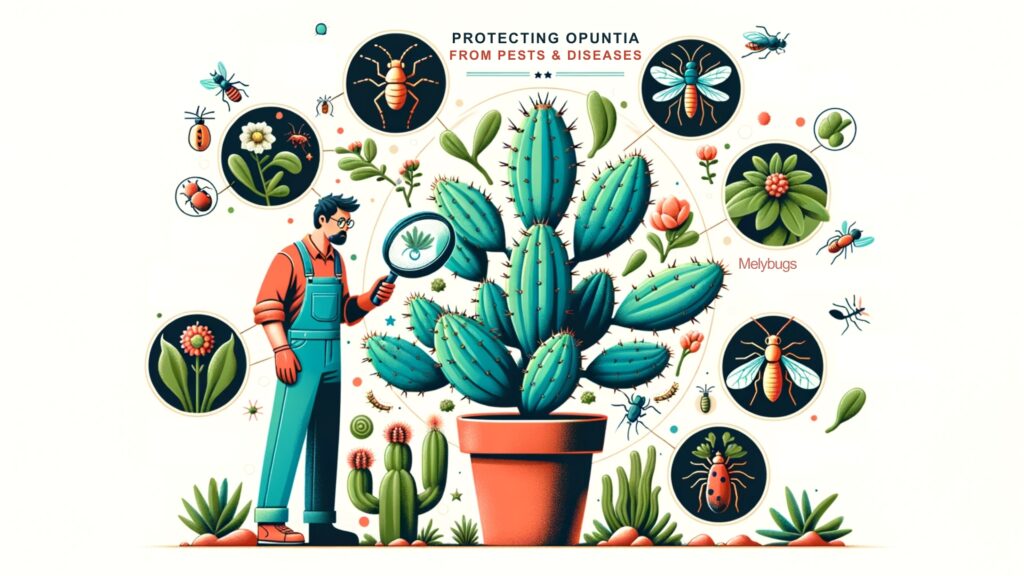
Opuntia is usually tough against pests, but it’s still important to check regularly:
- Common Pests: Sometimes aphids, mealybugs, or scale insects can appear. You can manage these pests by wiping them off or spraying the plant with water mixed with mild soap. Common Cactus Pests and How to Control Them
- Organic Pest Control: You can use insecticidal soaps or introduce helpful bugs like ladybugs to control pests. Neem oil is also a good natural option to treat pest problems without harming the environment. Using Neem Oil on Plants
Keeping your garden clean and tidy will also reduce the risk of pests and diseases. Remove fallen pads and debris to prevent pest infestations and fungal issues.
Pruning, Shaping, and Repotting Opuntia
How to Prune Opuntia
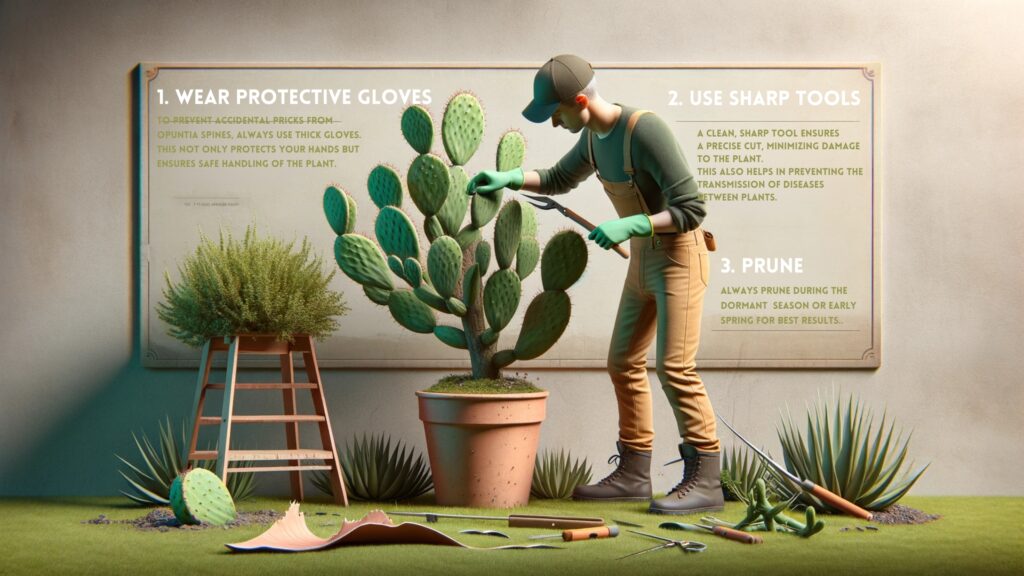
Pruning helps remove dead or diseased pads, improve air circulation, and keep the plant looking nice. Pruning can also help encourage new growth and shape the plant:
- Use Clean Tools: Always use clean tools to avoid spreading disease. Wipe them with rubbing alcohol or a bleach solution before use. Pruning Cactus Plants
- Wear Gloves: Thick gloves are needed to protect yourself from the spines, as even spineless Opuntia can have tiny glochids that are irritating.
- Best Time to Prune: Prune in early spring before new growth starts or during the plant’s dormant season. This way, the plant can put its energy into healthy growth.
Regular pruning will keep your Opuntia healthy and prevent it from becoming too large or crowded.
Repotting Opuntia
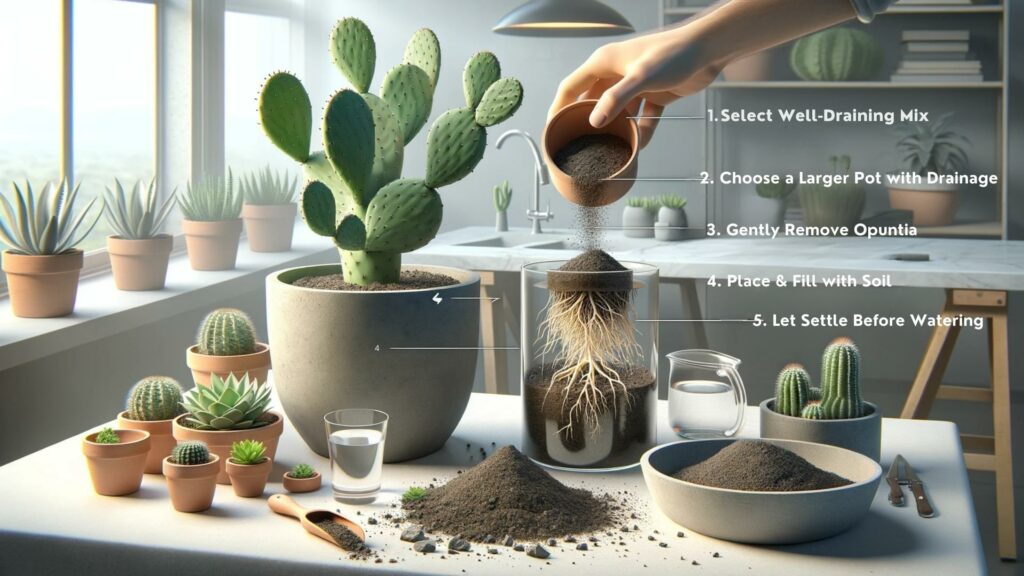
Repotting every few years helps keep Opuntia’s roots healthy:
- Use Well-Draining Soil. A mix of potting soil, sand, and perlite works well.
- Choose a pot with good drainage holes to avoid root rot.
- Carefully take the plant out of its old pot, gently loosening any tangled roots.
- Place the plant in the new pot and fill it with fresh soil.
- Let the plant settle for a few days before watering again. This gives the roots time to heal. How to Repot a Cactus
Making Beautiful Opuntia Arrangements

Opuntia’s unique shape and colorful flowers make it a great centerpiece in garden arrangements. It pairs well with other drought-tolerant plants like agaves, yuccas, and succulents, creating a beautiful xeriscape that needs little maintenance. The different shapes and textures of these plants make for a visually interesting garden that does well in hot, dry climates.
Opuntia can also be grown in pots for patios or indoor spaces, adding an exotic touch. Try planting several Opuntia species in one big pot for a layered, diverse look. Adding decorative stones or gravel on top of the soil can make it look even better and help retain moisture. How to Create Cactus and Succulent Arrangements
Harvesting and Utilizing the Fruits of Opuntia
Nutrition and Culinary Uses
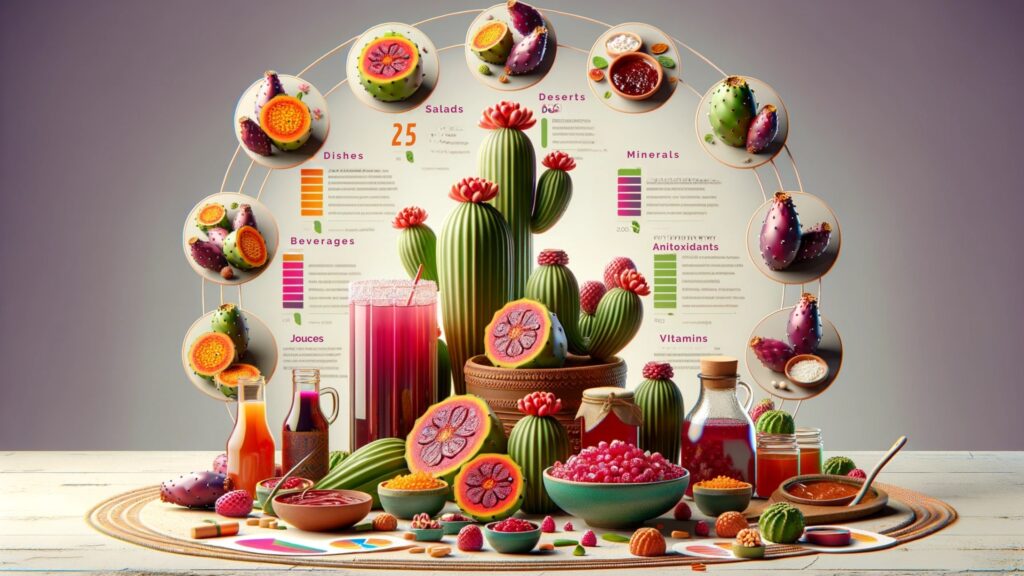
The fruit, called prickly pear, is packed with vitamins and antioxidants like vitamin C, magnesium, and fiber. Here are some ways to use it:
- Eating Raw: Add it to salads for a sweet, juicy touch. The bright colors also make it look great.
- Drinks and Jams: Prickly pear is popular in Mexican cooking for making drinks like aguas frescas or for tasty jams and jellies.
- Grilling and Roasting: The pads (nopal) are often grilled or roasted and used in dishes like tacos. Their slightly tangy flavor goes well with many meats and vegetables.
Using prickly pear in your cooking can bring new flavors and add nutritional benefits to your diet. Prickly Pear Recipes
Tips for Harvesting
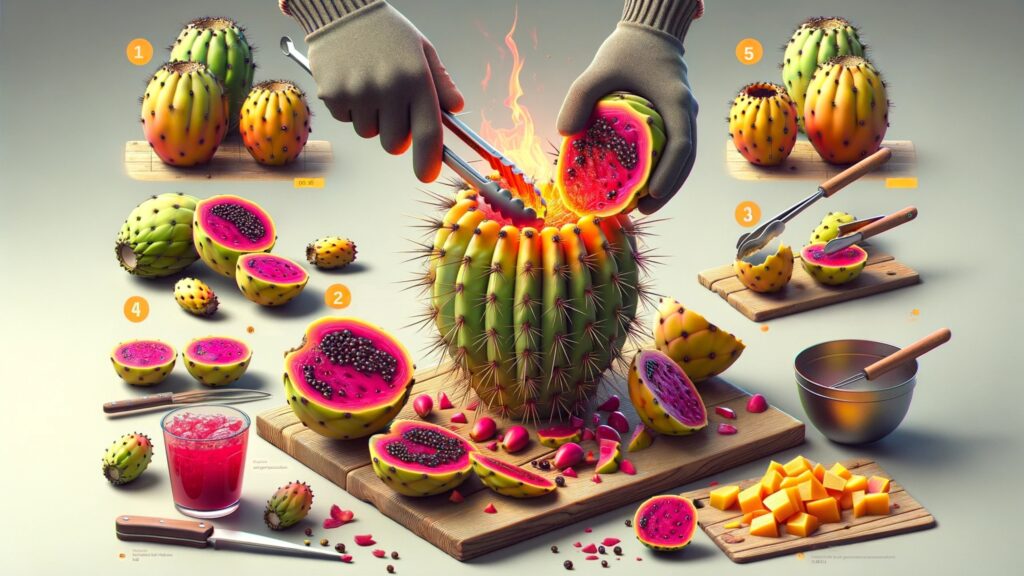
Handle prickly pears carefully to avoid getting hurt by the spines and glochids:
- Wear Gloves: Use gloves to protect your hands from the spines.
- Clean Well: Remove the spines and glochids by peeling the fruit or using a flame to burn them off. Once cleaned, you can slice, dice, or juice the fruit. How to Harvest and Eat Prickly Pear
- Harvest When Ready: Prickly pears are ready to pick when they turn a deep, vibrant color and feel slightly soft. Picking them at the right time will give you the best taste.
Traditional Medicine and Other Uses

Opuntia fruits have anti-inflammatory and antioxidant properties and have been used in traditional medicine for many things:
- Digestive Health: Prickly pear is used to help with digestive health and can ease stomach issues.
- Skincare: Extracts from Opuntia are popular in moisturizers because they help hydrate the skin. The oil from the seeds is rich in essential fatty acids, which are great for anti-aging and skin repair.
- Blood Sugar Control: Some studies suggest that eating prickly pear may help manage blood sugar levels, which can be helpful for people with type 2 diabetes.
Opuntia isn’t just a garden plant or food—it’s also valuable for health and well-being. Health Benefits of Prickly Pear
Conclusion
Opuntia, the fascinating prickly pear cactus, is more than just a beautiful plant; it’s a symbol of resilience and versatility. With its rich cultural history, vibrant flowers, and delicious fruits, Opuntia offers countless possibilities for gardeners and plant lovers alike.
Whether you are interested in creating stunning garden arrangements, enjoying its culinary delights, or exploring its medicinal benefits, Opuntia is an excellent choice.
Its ability to adapt to different climates and its minimal care needs make it perfect for both beginners and experienced gardeners.
Start your Opuntia journey today, and bring a touch of natural beauty and practicality to your garden.

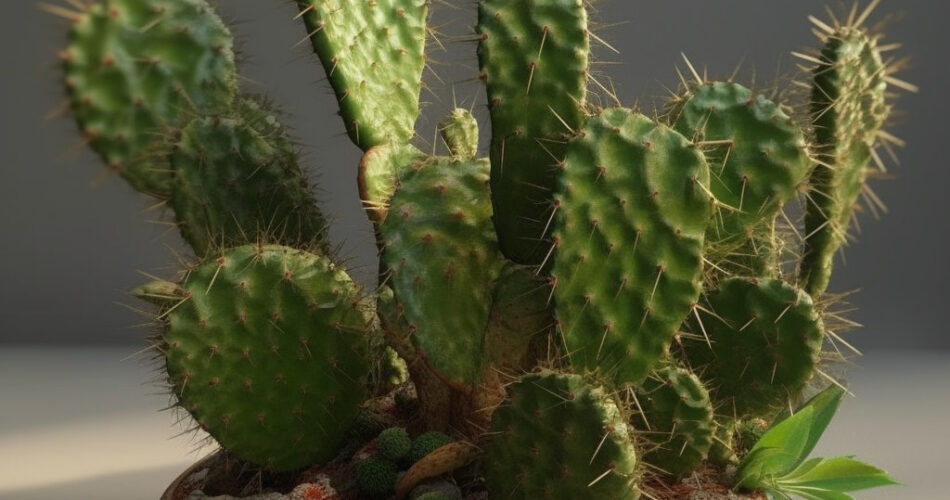


Comments